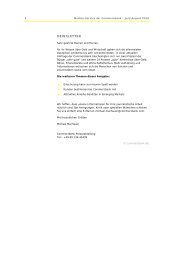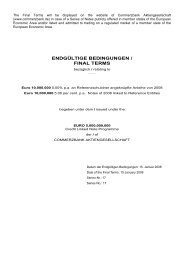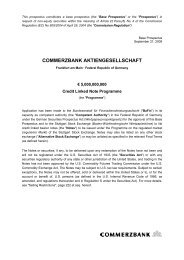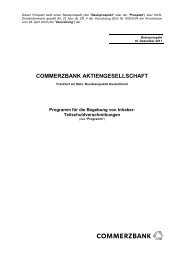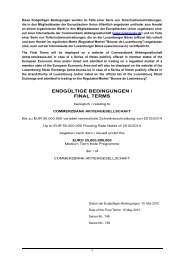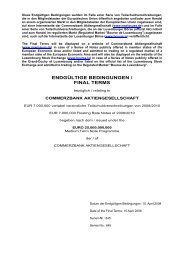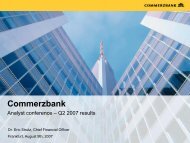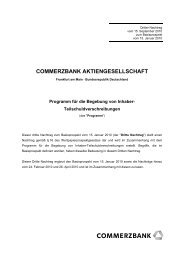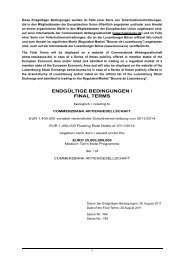COMMERZBANK AKTIENGESELLSCHAFT
COMMERZBANK AKTIENGESELLSCHAFT
COMMERZBANK AKTIENGESELLSCHAFT
You also want an ePaper? Increase the reach of your titles
YUMPU automatically turns print PDFs into web optimized ePapers that Google loves.
82<br />
Commerzbank AG<br />
Notes<br />
General information<br />
(1) Basis of preparation<br />
The financial statements of Commerzbank Aktiengesellschaft as<br />
of December 31, 2011 have been prepared in accordance with<br />
the provisions of the German Commercial Code (Handelsgesetzbuch,<br />
HGB) and the Regulation on the Accounting of Credit<br />
Institutions and Financial Services Institutions (RechKredV) and<br />
in accordance with the provisions of the German Stock Corporation<br />
Act (Aktiengesetz, AktG).<br />
The financial statements consist of the income statement, the<br />
balance sheet and the notes. In addition, a management report<br />
has been prepared in accordance with Art. 289 HGB.<br />
Unless otherwise indicated, all amounts are shown in millions<br />
of euro.<br />
(2) Accounting and measurementpolicies<br />
The cash reserve is stated at nominal value. Debt issued by<br />
public-sector borrowers is shown net present value. Claims on<br />
banks and customers are reported at their nominal value, less<br />
any valuation allowances that have been recognised. Differences<br />
between the acquisition cost and the nominal amount with<br />
interest-like characteristics are reported in accrued and deferred<br />
items and recognised successively over their entire lifetime in<br />
net interest income.<br />
Risks in the lending business are reflected by creating both<br />
specific loan loss provisions and general loan loss provisions for<br />
all on-balance-sheet claims and off-balance-sheet transactions<br />
using internal parameters and models. A distinction is made<br />
between significant and non-significant exposures. Provision is<br />
also made for country risks in these calculations. The level of the<br />
provision for each individual default risk is based on the<br />
difference between the carrying amount of the claim and the net<br />
present value of the expected future cash inflows on the claim,<br />
calculated using the discounted cash flow method and allowing<br />
for any collateral held. The regular reversal of loan loss<br />
provisions as a result of an increase in net present value is<br />
shown under interest income in the income statement.<br />
Securities in the liquidity reserve are shown according to the<br />
rules for current assets at the lower of acquisition cost or fair<br />
value with the strict lower-of-cost-or-market principle applied,<br />
unless they are reported as a hedge relationship. Securities held<br />
as fixed assets are treated in accordance with the modified lower<br />
of cost or market value principle.<br />
Equity holdings and holdings in affiliated companies are<br />
carried at amortised cost, in accordance with the rules for fixed<br />
assets. If the impairment of a holding is expected to be<br />
permanent, the carrying amount of the asset is written down. If<br />
the reasons for an impairment cease to exist, the asset is written<br />
up to a maximum of the amortised cost.<br />
Write-downs and valuation allowances are shown net of<br />
write-ups. If this relates to items in the trading portfolio, the<br />
amount is shown in net income in the trading portfolio. In the<br />
case of securities in the liquidity reserve, they are reported<br />
under write-downs and valuation allowances on loans and<br />
certain securities and allocations to provisions in lending<br />
business. In the case of securities held as investments they are<br />
reported under write-downs and valuation allowances on equity<br />
holdings, holdings in affiliated companies and securities shown<br />
as fixed assets.<br />
The trading portfolio is measured at fair value minus a risk<br />
charge in accordance with Art. 340e (3) HGB. The risk charge is<br />
calculated on the basis of the regulatory value at risk for market<br />
price risk. Own issues which have been bought back in the<br />
trading portfolio are shown net where there is no longer a debt<br />
outstanding.<br />
Repurchase agreements are stated in accordance with the<br />
current principles of Art. 340b HGB). In the case of securities<br />
lending transactions, securities lent continue to be recognised<br />
on the balance sheet of Commerzbank Aktiengesellschaft as long<br />
as the title is retained.<br />
Fixed assets are stated at acquisition or production cost, and,<br />
if applicable, less depreciation. The underlying useful lives are<br />
based on the general depreciation table published by the<br />
financial authorities. If an asset is permanently impaired, it is<br />
written down to the impaired value.<br />
Capitalised in-house developed intangible assets are<br />
recognised at the value of development costs incurred. Low value<br />
assets are recognised in accordance with the relevant local tax<br />
legislation simplification rules.<br />
Liabilities are stated at their settlement amount. Differences<br />
between the amount to be repaid and the amount paid are<br />
recognised as accrued and deferred items and recognised<br />
through income on a pro-rata basis. Non-current discounted<br />
liabilities (zero bonds) are recognised at net present value.



